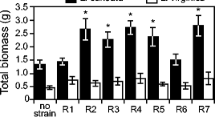Abstract
The degree of specialization in the legume–rhizobium mutualism and the variation in the response to different potential symbionts are crucial factors for understanding the process of invasion by exotic legumes and the consequences for the native resident plants and bacteria. The enhanced novel mutualism hypothesis predicts that exotic invasive legumes would take advantage of native rhizobia present in the invaded soils. However, recent studies have shown that exotic legumes might become invasive by using exotic introduced microsymbionts, and that they could be a source of exotic bacteria for native legumes. To unravel the role of novel and old symbioses in the progress of invasion, nodulation and symbiotic effectiveness were analyzed for exotic invasive plants and native co-occurring legumes in a Mediterranean coastal dune ecosystem. Although most of the studied species nodulated with bacteria from distant origins these novel mutualisms were less effective in terms of nodulation, nitrogenase activity and plant growth than the interactions of plants and bacteria from the same origin. The relative effect of exotic bradyrhizobia was strongly positive for exotic invasive legumes and detrimental for native shrubs. We conclude that (1) the studied invasive legumes do not rely on novel mutualisms but rather need the co-introduction of compatible symbionts, and (2) since exotic rhizobia colonize native legumes in invaded areas, the lack of effectiveness of these novel symbiosis demonstrated here suggests that invasion can disrupt native belowground mutualisms and reduce native legumes fitness.


Similar content being viewed by others
References
Barnet YM, Catt PC (1991) Distribution and characteristics of root-nodule bacteria isolated from Australian Acacia spp. Plant Soil 135:109–120
Burdon JJ, Gibson AH, Searle SD, Woods MJ, Brockwell J (1999) Variation in the effectiveness of symbiotic associations between native rhizobia and temperate Australian Acacia: within species interactions. J Appl Ecol 36:398–408
Dickie IA, Bolstridge N, Cooper JA, Peltzer DA (2010) Co-invasion by Pinus and its mycorrhizal fungi. New Phytol 187:475–484
Fernández-Pascual M, de Felipe M, Serra M, Pozuelo JM (1988) Effects of cianazine and Linuron on chloroplast development, nodule activity and protein metabolism in Lupinus albus L. J Plant Physiol 133:288–294
Guasch LM, de Felipe M, Fernández-Pascual M (2001) Effects of different O2 concentrations on nitrogenase activity, respiration and O2 diffusion resistance in Lupinus albus L. cv Multolupa nodules. J Plant Physiol 158:1395–1402
Lafay B, Burdon J (2006) Molecular diversity of rhizobia nodulating the invasive legume Cytisus scoparius in Australia. J Appl Microbiol 100:1228–1238
Lie TA, Göktan D, Engin M, Pijnenborg J, Anlarsal E (1987) Co-evolution of the legume–Rhizobium association. Plant Soil 100:171–181
Martinez-Romero E (2009) Co-evolution in rhizobium–legume symbiosis? DNA Cell Biol 28:361–370
Minchin FR, Iannetta PPM, Fernández-Pascual M, de Lorenzo C, Witty JF, Sprent JI (1992) A new procedure for the calculation of oxygen diffusion resistance in legume nodules from flow-through gas analysis data. Ann Bot 70:283–289
Muresu R, Polone E, Sulas L, Baldan B, Tondello A, Cappuccinelli P, Alberghini S, Benhizia Y, Benhizia H, Mori B, Calamassi R, Dazzo FB, Squartini A (2008) Coexistence of predominantly nonculturable rhizobia with diverse, endophytic bacterial taxa within nodules of wild legumes. FEMS Microbiol Ecol 63:383–400
Nuñez MA, Horton TR, Simberloff D (2009) Lack of belowground mutualisms hinders Pinaceae invasions. Ecology 90:2352–2359
Parker MA (2001) Mutualism as a constraint on invasion success for legumes and rhizobia. Divers Distrib 7:125–136
Parker MA, Malek W, Parker IM (2006) Growth of an invasive legume is symbiont limited in newly occupied habitats. Divers Distrib 12:563–571
Perez-Fernandez MA, Lamont BB (2003) Nodulation and performance of exotic and native legumes in Australian soils. Aust J Bot 51:543–553
Pringle A, Adams RI, Cross HB, Bruns TD (2009) The ectomycorrhizal fungus Amanita phalloides was introduced and is expanding its range on the west coast of North America. Mol Ecol 18:817–833
Qian JH, Kwon SW, Parker MA (2003) rRNA and nifD phylogeny of Bradyrhizobium from sites across the Pacific Basin. FEMS Microbiol Lett 219:159–165
Reinhart KO, Callaway RM (2006) Soil biota and invasive plants. New Phytol 170:445–457
Richardson DM, Rejmánek M (2011) Trees and shrubs as invasive alien species—a global review. Divers Distrib 17:788–809
Richardson DM, Allsopp N, D’Antonio CM, Milton SJ, Rejmánek M (2000) Plant invasions—the role of mutualisms. Biol Rev 75:65–93
Rodríguez-Echeverría S (2010) Rhizobial hitchhikers from Down Under: invasional meltdown in a plant-bacteria mutualism? J Biogeog 37:1611–1622
Rodríguez-Echeverría S, Perez-Fernandez MA, Vlaar S, Finan TM (2003) Analysis of the legume–rhizobia symbiosis in shrubs from central western Spain. J App Microbiol 95:1367–1374
Rodríguez-Echeverría S, Crisostomo JA, Freitas H (2007) Genetic diversity of rhizobia associated with Acacia longifolia in two stages of invasion of coastal sand dunes. App Environ Microbiol 73:5066–5070
Rodríguez-Echeverría S, Crisostomo JA, Nabais C, Freitas H (2009) Belowground mutualists and the invasive ability of Acacia longifolia in coastal dunes of Portugal. Biol Invasions 11:651–661
Rodríguez-Echeverría S, Le Roux JJ, Crisostomo JA, Ndlovu J (2011) Jack-of-all-trades and master of many? How does associated rhizobial diversity influence the colonization success of Australian Acacia species? Divers Dist 17:946–957
Ruiz-Diez B, Fajardo S, Puertas-Mejia MA, De Felipe MR, Fernandez-Pascual M (2009) Stress tolerance, genetic analysis and symbiotic properties of root-nodulating bacteria isolated from Mediterranean leguminous shrubs in Central Spain. Arch Microbiol 19:35–46
Sinclair TR, Serraj R (1995) Legume nitrogen fixation and drought. Nature 378:344
Somasegaran P, Hoben H (1994) Handbook for rhizobia: methods in legume–Rhizobium technology. Springer, Heidelberg
Sprent JI (1994) Evolution and diversity in the legume–rhizobium symbiosis: chaos theory? Plant Soil 161:1–10
Sprent JI, James EK (2007) Legume evolution: where do nodules and mycorrhizas fit in? Plant Physiol 144:575–581
Stanton-Geddes J, Anderson CG (2011) Does a facultative mutualism limit species range expansion? Oecologia 167:149–155
Thrall PH, Burdon JJ, Woods MJ (2000) Variation in the effectiveness of symbiotic associations between native rhizobia and temperate Australian legumes: interactions within and between genera. J Appl Ecol 37:52–65
Thrall PH, Laine A-L, Broadhurst LM, Bagnall DJ, Brockwell J (2011) Symbiotic effectiveness of rhizobial mutualists varies in interactions with native Australian legume genera. PLoS ONE 6:e23545
Traveset A, Richardson DM (2006) Biological invasions as disruptors of plant reproductive mutualisms. Trends Ecol Evol 21:208–216
Valladares F, Villar-salvador P, Dominguez S, Fernández-Pascual M, Peñuelas JL, Pugnaire FI (2002) Enhancing the early performance of the leguminous shrub Retama sphaerocarpa (L.) Boiss.: fertilisation versus Rhizobium inoculation. Plant Soil 240:253–262
Van der Putten WH, Klironomos JN, Wardle DA (2007) Microbial ecology of biological invasions. ISME J 1:28–37
Wall DH, Bardgett RD, Kelly E (2010) Biodiversity in the dark. Nat Geosci 3:297–298
Wei G, Chen W, Zhu W, Chen C, Young JPW, Bontemps C (2009) Invasive Robinia pseudoacacia in China is nodulated by Mesorhizobium and Sinorhizobium species that share similar nodulation genes with native American symbionts. FEMS Microbiol Ecol 68:320–328
Weir BS, Turner SJ, Silvester WB, Park DC, Young JM (2004) Unexpectedly diverse Mesorhizobium strains and Rhizobium leguminosarum nodulate native legume genera of New Zealand, while introduced legume weeds are nodulated by Bradyrhizobium species. Appl Environ Microbiol 70:5980–5987
Acknowledgments
This work was supported by the project MUTUALNET (PTDC/BIA-BEC/103507/2008), from the European Union and the Portuguese Foundation for Science and Technology, and the project POII10-0211-5015 from the Junta de Comunidades de Castilla-La Mancha, Spain. The experiments comply with the current laws of the country in which the experiments were performed.
Author information
Authors and Affiliations
Corresponding author
Additional information
Communicated by Catherine Gehring.
Rights and permissions
About this article
Cite this article
Rodríguez-Echeverría, S., Fajardo, S., Ruiz-Díez, B. et al. Differential effectiveness of novel and old legume–rhizobia mutualisms: implications for invasion by exotic legumes. Oecologia 170, 253–261 (2012). https://doi.org/10.1007/s00442-012-2299-7
Received:
Accepted:
Published:
Issue Date:
DOI: https://doi.org/10.1007/s00442-012-2299-7




